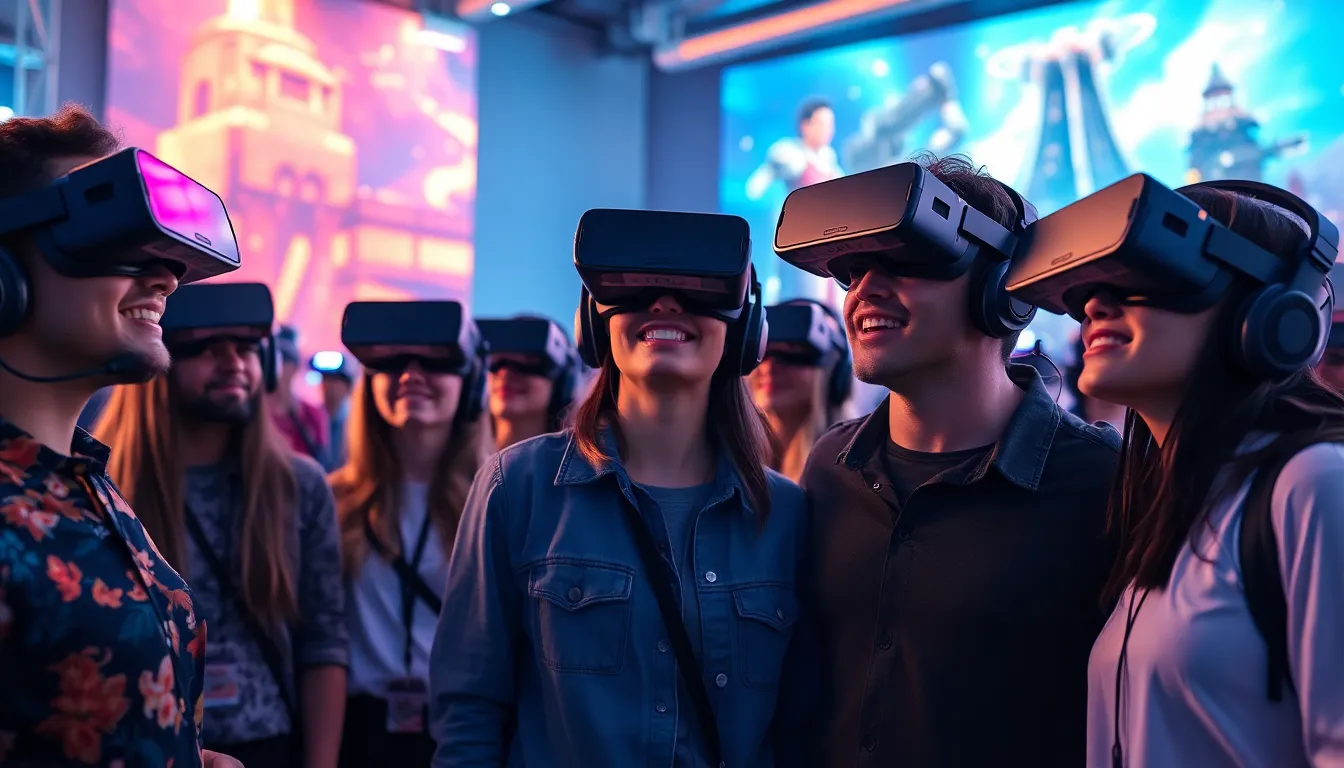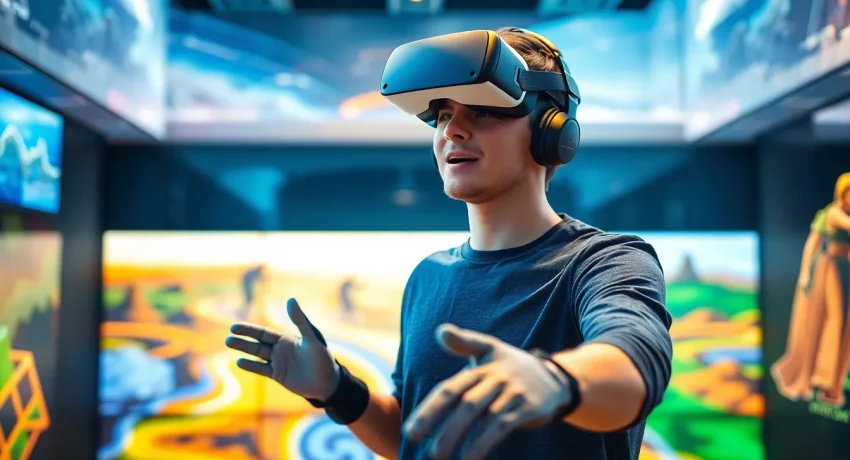Table of Contents
ToggleVirtual reality (VR) experiences have transformed the way people interact with digital content, offering immersive adventures that blur the lines between reality and imagination. From gaming to education and therapy, VR technology captivates users by transporting them to entirely new worlds. As the technology continues to evolve, its applications are becoming more diverse and accessible.
As users don headsets and step into these virtual realms, they discover endless possibilities for entertainment, learning, and social interaction. This article explores the fascinating landscape of VR experiences, highlighting the latest innovations and how they’re reshaping various industries. Whether someone is a seasoned gamer or a curious newcomer, the allure of VR promises to engage and inspire like never before.
Overview of VR Experiences
Virtual reality (VR) experiences provide an engaging platform for users to explore interactive digital environments. VR technology immerses individuals by simulating realistic experiences, allowing them to interact with virtual worlds. Key applications of VR include:
- Gaming: Immersive gameplay engages users like never before. Players can experience 360-degree views and realistic interactions. Popular titles, like “Beat Saber” and “Half-Life: Alyx,” showcase VR’s potential in gaming.
- Education: VR transforms learning by creating interactive simulations. Students can explore historical events or conduct scientific experiments in virtual labs. Programs such as Oculus for Education demonstrate VR’s effectiveness in enhancing education.
- Therapy: VR aids in therapeutic practices, treating conditions like anxiety and PTSD. Controlled environments help patients confront fears gradually. Research supports VR’s effectiveness in exposure therapy.
- Training: Industries leverage VR for training simulations, enhancing skills without real-life consequences. Sectors like aviation and healthcare utilize VR for realistic training modules.
Recent advancements in VR technology have made experiences more accessible. Improved hardware, decreased costs, and diverse content cater to a broader audience. The rise of standalone headsets, which require no external devices, further enhances user engagement.
VR experiences evoke emotional responses, allowing users to connect deeply with content. As VR continues evolving, its applications expand, promising new ways to interact with digital landscapes.
Types of VR Experiences

Various types of VR experiences immerse users in interactive digital environments. Key categories include gaming, education, therapy, and social interaction.
Gaming
Gaming represents one of the most popular applications of VR. Users experience 360-degree gameplay with realistic graphics and sound, creating a sense of presence. Titles like “Beat Saber” and “Half-Life: Alyx” exemplify engaging gameplay that utilizes VR’s immersive capabilities, leading to enhanced player satisfaction. Competitive gaming environments also adapt to VR, providing a unique twist to traditional formats and attracting a growing audience.
Education
Education leverages VR to revolutionize learning methodologies. Interactive simulations allow students to navigate complex concepts and real-world scenarios. Programs such as Oculus for Education offer immersive experiences in subjects like history and science, enhancing student engagement. Virtual labs let learners conduct experiments without the risks associated with physical materials, making education safer and more accessible.
Therapy
Therapeutic applications of VR support mental health treatments. Controlled virtual environments facilitate exposure therapy for conditions such as anxiety and PTSD. Patients gradually confront their fears within a safe space, promoting healing and coping strategies. Research indicates that VR can effectively complement traditional therapeutic techniques, paving the way for innovative mental health treatments.
Social Interaction
Social interaction through VR fosters connections in virtual spaces. Users can engage with others in shared environments, enhancing social experiences far beyond traditional platforms. VR chatrooms and multiplayer games enable meaningful interactions, allowing participants to form relationships regardless of geographical barriers. This aspect of VR promotes inclusivity and strengthens community ties.
Benefits of VR Experiences
VR experiences offer numerous advantages in diverse fields, enhancing engagement and interaction. The following sections detail specific benefits in immersive learning and enhanced entertainment.
Immersive Learning
Immersive learning through VR enables students to engage with educational content in dynamic ways. Users interact with simulations that replicate real-world scenarios, making concepts easier to comprehend. Programs like Oculus for Education utilize virtual environments to explore historical events, providing students with firsthand experiences that traditional classrooms cannot offer. Studies show that immersive learning increases information retention, as participants actively engage with material rather than passively receiving it. This method enhances critical thinking and problem-solving skills, preparing students for real-world applications.
Enhanced Entertainment
Enhanced entertainment through VR transforms how users experience gaming and media. Immersive gameplay allows participants to step into virtual worlds, experiencing narratives and environments with unprecedented depth. Titles like “Beat Saber” and “Half-Life: Alyx” showcase this capability, featuring 360-degree views and responsive interactions. Users actively participate in the storyline, fostering a sense of presence and emotional connection. Additionally, VR social experiences offer users the chance to interact with others in shared environments, further elevating the entertainment value. As VR technology evolves, its ability to create engrossing experiences continues to captivate audiences across various genres.
Challenges of VR Experiences
VR experiences face several challenges that can impact usability and user satisfaction. Addressing these issues is essential for enhancing accessibility and overall engagement.
Accessibility Issues
Accessibility remains a significant challenge in VR. High costs of quality headsets and equipment limit widespread adoption. Additionally, VR content often lacks compatibility for individuals with disabilities. Many applications do not have features catering to users who are visually or hearing impaired. As VR technology evolves, developers must prioritize inclusive design, ensuring that all users can engage with virtual environments seamlessly.
Motion Sickness
Motion sickness commonly affects users during VR experiences due to discrepancies between visual movements and physical sensations. Symptoms can include dizziness, nausea, and disorientation. Studies indicate that nearly 40% of users experience some form of motion sickness while using VR. Factors that contribute to this issue include frame rate, latency, and the type of movement provided in gameplay. Developers can mitigate these effects by optimizing frame rates, minimizing latency, and incorporating user-friendly movement mechanics, ultimately enhancing user comfort and satisfaction.
Future of VR Experiences
Future VR experiences promise enhanced realism and immersion through advanced technology. Enhanced graphics, higher resolution displays, and improved haptic feedback create more convincing simulations. Innovations in artificial intelligence (AI) and machine learning (ML) will enable more interactive and adaptive environments, making experiences dynamic and personalized.
Future applications of VR span beyond gaming and education. Healthcare uses VR for remote surgery training, enabling surgeons to hone skills in risk-free settings. Real estate showcases properties through virtual tours, allowing potential buyers to explore homes from anywhere. Retailers create virtual shopping experiences, merging convenience with immersive product exploration.
Future advancements in social VR aim to deepen connections among users. Platforms will enable robust virtual interactions, with real-time collaboration tools for work or play. Social VR spaces will integrate augmented reality (AR), blending real-world elements with virtual content, creating unique shared experiences.
Future accessibility improvements focus on making VR inclusive. Developers will design headsets and applications for users with varying needs, reducing barriers. Enhanced user interfaces and customizable settings will cater to individuals with disabilities, promoting broader adoption.
Future VR experiences will address health concerns such as motion sickness. Ongoing research into user comfort will refine movement mechanics and frame rates. Adaptive systems will monitor user reactions and adjust experiences accordingly to mitigate discomfort.
Future developments prioritize sustainability in VR technology. Environmentally conscious production methods and materials will minimize ecological impact. As hardware evolves, energy-efficient systems will reduce power consumption during use.
Future VR experiences hold potential for significant cultural impact. Artists and creators will explore VR’s capabilities, pushing boundaries in storytelling and expression. Educational institutions will broaden curricula to include VR tools, enriching learning frameworks with immersive and engaging materials.
The evolution of VR experiences is reshaping how individuals interact with technology and each other. As this immersive medium continues to advance, it opens doors to new possibilities in various fields. Enhanced realism and accessibility will likely drive broader adoption, making VR a staple in education, therapy, and entertainment.
Future developments promise to address existing challenges while fostering deeper connections through social VR. By prioritizing inclusivity and sustainability, the industry can ensure that VR experiences are enjoyable and beneficial for everyone. As creators and innovators explore the potential of this technology, the cultural impact of VR will undoubtedly grow, enriching storytelling and learning for generations to come.




